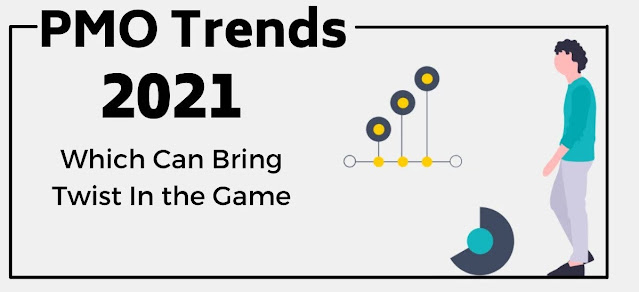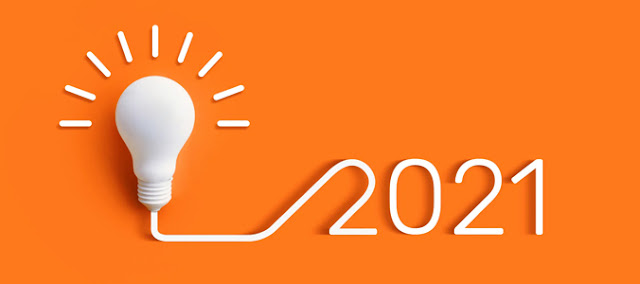It is evident that this year 2020, has undoubtedly been one of the most complicated of this century at all levels, not only because of the atypical nature of all the circumstances but also because the impact has been global, it has undoubtedly been an impact. 99.99% worldwide.
Read More: PMI Project Management Professional (PMP)
Against this background, I want to share my vision as a PMO on the below-mentioned trends for a PMO for 2021.
1. Virtual PMO
2. Hybrid PMO
3. Blockchain technology
4. PMO Bots & RPA Bots
I see these as the key drivers who can have an impact on PMO. All these drivers can potentially trend in 2021 for PMO.
I will be sharing the Current Scenario and the Future Scenario with solutions and proper recommendations.
The five big winners (hard to know and believe who has an efficient PMO)
◉ Before I start with the real-time action, we will make an addition since the impact is not only been in a country, region, sector, or a specific industry; of course, as in every crisis, opportunities are generated with significant exceptions for companies. Digital entertainment, telecommunications, logistics and supplies, electronic commerce, and those pharmaceutical companies in a frantic race to get a vaccine can be considered the five great beneficiaries.
◉ Honestly, it is not easy to know and believe who has an efficient PMO; I do not think anyone has an efficient PMO from my experience. However, it is essential to mention that digital entertainment companies most likely have an Agile Transformation Office where the products and the operation have a very high maturity managing the entire portfolio.
1. Virtual PMO
Very evident this trend for this 2021, has been to promote Remote Work where it was shown that the vast majority of organizations were not prepared for it, to mention the most obvious:
◉ Senior Management's reluctance to "school trip" needs to "see people know what to work for."
◉ A few "Managers or Directors" who don't know how to delegate or execute can become a bottleneck. These are the organization's known problems but mainly on the part of all tactical and operational teams. But with remote work, the rest of the organization has found out (another thing is to look the other way).
◉ There are obsolete technological infrastructures at the telecommunications and systems-level to work remotely beyond 24x7 technical support teams.
2. Hybrid PMO
All organizations have project portfolios, and by 2021 the product portfolio will increase because the trend of digital services will continue; therefore, it will be necessary to logically manage a hybrid portfolio (projects and products).
I look forward to what PMI will bring with PMBOK® Guide - Seventh Edition (and the one to be available soon) and its vision for "Hybrid Project Management and Direction" with DA's acquisition! It can be a significant boost, or on the contrary, it will be a simple "facelift" to continue promoting training and certifications but a minimal contribution to actual execution in organizations.
Personal reflection: I hope that PMI's contribution to Agility is much more important than what has been seen up to now with the purchase of DA (Disciplined Agile) because today I see many people giving the certification courses in DA when they have never managed a PMO or even led projects and products under agile frameworks.
On the other hand, Axelos has a more flexible methodology such as PRINCE2, but they have not yet dived quality to adopt more Agility in Product management.
3. Blockchain technology
Undoubtedly, technology should be a support pillar for all PMOs; blockchain technology can (and should) be used for Project and Product Management but very mainly in Public Administration (At the Government level of each country). It is intrinsically related to the other two: Virtual Hybrid PMO because ALL OF us pay all the resources used both at a technical, technological, and human level through our taxes!
And as such, they must be managed efficiently and today more than ever
4. PMO Bots & RPA Bots
There are several bots available within slack and other API interfaces based messaging systems. These bots can do a lot more mundane tasks, and administration works. Not only PMO bots there are several Robotics Process Automation solution available in the market which can come handy for PMOs like, UiPath, Blue Prism, Epiplex, Laserfiche, WinAutomation by Softomotive, ElectroNeek Pega, which can create bots which can work either alongside human or independently. There are two kinds of bots; attended and unattended bots. The bots that work alongside humans are called attended bots, and the bots that can work independently are called unattended bots. Mainly attended bots can be used in PMO to take care of the repetitive tasks like daily stand up, status reporting, Holiday planner, Milestones reminder, and many other reporting that can be taken care of by attended bots. I have been using Geekbot, Glossbot, and Tettrabot, and I find them very useful. Geekbots. I can visualize that bots can trend in 2021 for PMO, bringing many positive aspects to the entire PMO community.
We have already discussed the things that can trend for PMO in 2021. Now I will share the Current v/s Future Scenario for those trends I have already explained on the top.
1. Virtual PMO
Current Scenario
The Operational, Administrative or Support PMOs are no longer useful; the leader or person in charge of the PMO must "reinvent himself" and "(Re) Design his PMO" if he is capable.
The vast majority of those responsible for these PMOs continue to use the SXIX approach "I go for + low price" to reduce costs by hiring people with the lowest possible salaries to make the company believe that "you save costs" when the reality is that they continue to give the same results "PROJECTS FAILED IN TIME AND BUDGET."
Future Scenario:
◉ The PMOfficers that have (Re) Designed and Implemented a Hybrid PMO, or a Government PMO in their organizations are currently giving the best results because their working processes, model, strategy, and already established teams were only adapted to the new needs of the organization.
◉ If your PMO is in the (Re) Design Phase, you should consider these two options and see which is the one that best adapts to the reality of your organization over time.
◉ On the other hand, I consider that one of the great opportunities that the current situation has left us for a PMO are three pillars:
◉ Integration: there will be greater integration between the business units with all the technical and technological resources since the vast majority of the products and services that we will use will be digitally available in the Cloud. The PMO must have global visibility of all this to timely inform everything related to the portfolio at a Strategic, Tactical, and Operational level (essential for the transition to the Service phase before the start-up of the project product-led from the PMO).
◉ Collaboration: the PMO with a 360-degree global vision of the entire organization must be a fundamental catalyst to promote collaboration between resources and manage, digest, and solve any existing problem for the entire portfolio of projects and products.
◉ Transparency: without a doubt, all the bad practices inherited from many years in the organization will be gradually eliminated (either due to ignorance or consciously by the same people); the PMO as a catalyst entity must promote not only them but also EXECUTE THEM!
The PMO must share the information, or at least make it visible to the groups:
Strategic: senior Management, PMO sponsor, the steering group of stakeholders, etc.
Tactics: program manager, project manager, program product owner, digital project manager, next-level stakeholder steering group or other business units, etc.
Operational: technical project manager, project leader, product owners, development teams, systems teams involved in deployments, etc.
2. Hybrid PMO
Current Scenario
Unfortunately, in most organizations, "agility" plays a bigger role. People see the struggle between traditional methods in project management vs. applying agile frameworks "as the only salvation for the business."
The image that they have transmitted for years between propaganda of superheroes the image remains in my retina as a Fraticidal Fight between the "JEDI" vs. the "SITH". . . . . but it is not clear who is who between "waterfall vs. agile."
Personal reflection: when someone wants to impose absolute truths, it always, without exception, hurts both people and organizations; That is why I have always rejected as silly any apology they make of superheroes, dances, or the like at any event, no matter who does it or who promotes it.
Future Scenario:
◉ Both the methodology coexists. Depending on both internal and external clients, which of the frameworks should be used, when and in what form.
◉ There are Hybrid Projects: where most of them will use a traditional framework, and to a lesser extent, it will be managed under an agile framework.
◉ There are Hybrid Products: where most of it will be used as an agile framework, and to a lesser extent, it will be managed under a traditional framework.
3. Blockchain Technology
◉ If your organization continues to use only XLS + PPT for portfolio reporting, the leadership of both the person Responsible for the PMO (he cannot be identified as a PMOfficer) and the Sponsor of the same are obsolete.
◉ There may be applications in the Cloud that help (and a lot) to manage a portfolio, mainly PPM solutions (portfolio/program project management tools), but the high cost of licenses, implementation, and subsequent support of some of these solutions outside Large companies make them unviable for the vast majority of organizations, mainly SMEs.
Future Scenario
◉ Once an organization has solved efficient Management through a Tool (PPM purchased or developed within the company itself), the next step is undoubtedly Blockchain.
◉ Project and Product Management is not just assigning projects, tasks, and reporting them. It is much more than that. Blockchain technology can be considered in Portfolio Management to secure data between all of them. It is mainly useful when there are different business units, cities, and countries involved since all that data must be stored in the Cloud securely without the need for the cybersecurity team.
4. PMO Bots & RPA Bots
Current Scenario
◉ Currently, only a few organizations are leveraging PMO bots and RPA bots, but it's not full-fledged.
◉ Currently, organizations are still reliant on humans to do the repetitive work, which frustrates the resources, as it restricts the growth and learning curve of the resources and triggers higher attrition.
◉ I am sure organizations are still struggling to get the accountability of these mundane and repetitive tasks, and each time the PMO team, either a PMO coordinator or an analyst, ended up doing it. As a result, the PMO analyst or a coordinator always ended up in a furrow of working on low-level and repetitive tasks.
Future Scenario
◉ If organizations learn to leverage bots, RPA bots, and an available API interface-based messaging system, it could resolve their issue. As per the trend in 2020, I can visualize that organizations would show their interest in bots and other available automation.
◉ Organizations will trust and interest bots, RPA bots, and automation processes to automate the mundane and repetitive tasks, which could help the Project coordinator and analysts focus on the other aspects of PMO functions.
◉ This shift organization's PMO to grow mature and more efficient compared to their previous years. It could break the stereotypic work of PMO, and I can visualize that PMO is up for setting up a new trend in 2021.
Source: novelvista.com






0 comments:
Post a Comment